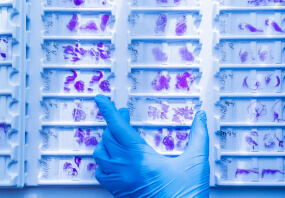General description
Brahma-related gene 1 (Brg1), also known as SWI/SNF related, matrix associated, actin dependent regulator of chromatin, subfamily a, member 4 (SMARCA4), is encoded by the gene mapped to human chromosome 19p13.2. The encoded protein is characterized with a conserved catalytic ATPase domain, a conserved C-terminal bromodomain, AT-hook motif and the less characterized N-terminal region housing QLQ, helicase-SANT-associated (HSA) and BRM and KIS (BRK) domains.
Monoclonal Anti-Brg1 (rat IgG2a isotype) is derived from the hybridoma 5B7 produced by the fusion of mouse myeloma cells (SP2) and splenocytes from rat immunized with a fusion protein corresponding to a fragment of human Brg1. Brahma-related gene 1 (Brg1) catalytic subunit of mammalian SWItch/sucrose non-fermentable (SWI/SNF)-related complexes co-localizes with origin recognition complexes, GINS complexes and proliferating cell nuclear antigen.
Application
Applications in which this antibody has been used successfully, and the associated peer-reviewed papers, are given below.
Chromatin immunoprecipitation (1 paper)
Monoclonal Anti-Brg1 antibody produced in rat has been used in:
- immunoblotting
- immunocytochemistry
- immunoprecipitation
- chromatin immunoprecipitation
Biochem/physiol Actions
Brahma-related gene 1 (Brg1) acts as a transcriptional repressor. It interacts with retinoblastoma tumor suppressor to form a repressor complex which inhibits cell cycle proteins such as cyclins A, D1 and E. Brg1 plays an important role as tumor suppressor to maintain genome stability and prevent cancer.
Brahma-related gene 1 (Brg1), acts as a catalytic subunit for various mammalian SWItch/Sucrose non-fermentable (SWI/SNF) complexes, where it helps in transcription regulation through the nucleosome remodelling. Additionally, it plays an essential role in differentiation of myeloid to granulocytes. Mutation in the gene is associated with the development of Coffin-Siris syndrome and rhabdoid tumor predisposition syndrome. Loss of Brg1 expression is used as a potential diagnostic marker for ovarian small cell carcinoma of the hypercalcemic type (SCCOHT).
Physical form
Solution in 0.01 M phosphate buffered saline pH 7.4, containing 15 mM sodium azide
Disclaimer
Unless otherwise stated in our catalog or other company documentation accompanying the product(s), our products are intended for research use only and are not to be used for any other purpose, which includes but is not limited to, unauthorized commercial uses, in vitro diagnostic uses, ex vivo or in vivo therapeutic uses or any type of consumption or application to humans or animals.
Shipping Information:
Dry Ice Surcharge & Ice Pack Shipments: $40
More Information: https://cenmed.com/shipping-returns
- UPC:
- 51241814
- Condition:
- New
- Availability:
- 3-5 Days
- Weight:
- 1.00 Ounces
- HazmatClass:
- No
- MPN:
- SAB4200195-200UL
- Temperature Control Device:
- Yes












